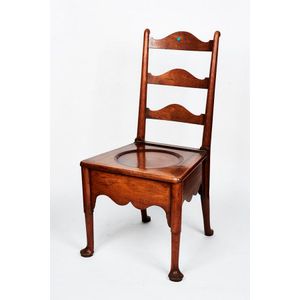Biedermeier Mahogany Scroll Sofa in Gold Damask
You must be a subscriber, and be logged in to view price and dealer details.
Subscribe Now to view actual auction price for this item
When you subscribe, you have the option of setting the currency in which to display prices to $Au, $US, $NZ or Stg.
- Damask - Damask is a type of fabric that is characterized by its glossy finish, smooth texture, and intricate designs. The fabric is typically made from a combination of silk and other natural fibers, such as cotton or linen, and is often used to make clothing, upholstery, and other decorative items.
The origins of damask fabric can be traced back to ancient Rome and the Byzantine Empire, where it was used to make clothing and other textiles.
The fabric is made by weaving the fabric in such a way that the design is created by the different reflectivity of the warp and weft threads, rather than by the use of dyed threads. The designs are often floral or geometric patterns and can be very intricate. The effect is a reversible fabric, with a glossy pattern on one side and a matte pattern on the other. - Mahogany - Mahogany is a dense, close grained red-coloured timber from the West Indies and Central America. It was first imported into Europe in the the early 18th century and its use continued through the 19th century. It was popular for furniture making because of its strength, the wide boards available, the distinctive grain on some boards, termed flame mahogany and the rich warm colour of the timber when it was polished.. The "flame" was produced where a limb grew out from the trunk of the tree, and this timber was usually sliced into veneers for feature panels on doors, backs and cornices.
Some terms used to describe mahogany relate to the country from which it originally came, such as "Cuban" mahogany, "Honduras" mahogany etc. However unless the wood has been tested the names assigned are more a selling feature, rather than a true indication of the timber's origin. - Block Feet - Block feet are usually found on square or sometimes tapered legs. Although the basic block foot is square on all sides, there are variations including a tapered block foot, moulded block foot and carved block foot.
This item has been included into following indexes:
Visually similar items

Florence Knoll (American, b. 1917), Armless Lounge Chair, manufactured by Knoll International, mustard wool upholstery, bearing 'Knoll International Ltd. Distributed under licence in Australia by Form Pty. Ltd. European labour only' label, height 76 cm, wi

Victorian mahogany commode chair, 19th century, with ladder back and shaped apron, height 99 cm

A George III style wing-back arm chair, English, 19th century, upholstered in yellow damask silk. Provenance: Property of a Gentleman, Melbourne

A gilt and cream painted three seater canape upholstered in original russet velvet fabric Italian 19th century 99 cm high, 176 cm wide, 56 cm deep
